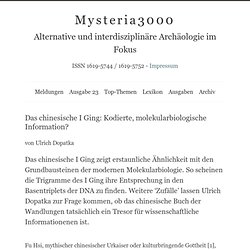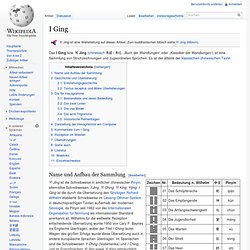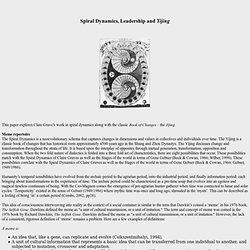

Learn.Genetics™ Das chinesische I Ging: Kodierte, molekularbiologische Information? – Mysteria3000. Von Ulrich Dopatka Das chinesische I Ging zeigt erstaunliche Ähnlichkeit mit den Grundbausteinen der modernen Molekularbiologie.

So scheinen die Trigramme des I Ging ihre Entsprechung in den Basentriplets der DNA zu finden. Weitere ‘Zufälle’ lassen Ulrich Dopatka zur Frage kommen, ob das chinesische Buch der Wandlungen tatsächlich ein Tresor für wissenschaftliche Informationenen ist. Fu Hsi, mythischer chinesischer Urkaiser oder kulturbringende Gottheit [1], hatte nach der Legende ein kurioses Erlebnis: Er sah, wie ein “Drachenpferd” aus den Fluten des Hoangho, des gelben Flusses, aufstieg, das auf dem Rücken Zeichen oder Markierungen trug.
Diese Zeichenfolge, die sogenannte Ho-Tu-Karte, bildet die Grundlage zum I Ging, dem Buch der Wandlungen [2]. Oft abgezeichnet und vielleicht auch manipuliert, stellt diese Karte eine Anordnung von zwei Arten von Punkten dar. Alles noch ohne Stirnrunzeln: Dieses System spiegelt lediglich eine simple logische Ordnung wieder. Literaturverzeichnis. I Ging. Das I Ging bzw.

Yì Jīng (chinesisch 易經 / 易经, „Buch der Wandlungen“ oder „Klassiker der Wandlungen“) ist eine Sammlung von Strichzeichnungen und zugeordneten Sprüchen. Es ist der älteste der klassischen chinesischen Texte. Name und Aufbau der Sammlung[Bearbeiten] Yì Jīng ist die Schreibweise in amtlicher chinesischer Pinyin; alternative Schreibweisen: I Jing, Yi Ching, Yi King, Yijing. I Ging ist die durch die Übersetzung des Sinologen Richard Wilhelm etablierte Schreibweise im Lessing-Othmer-System in deutschsprachigen Texten außerhalb der modernen Sinologie, da Pinyin seit 1982 von der Internationalen Organisation für Normung als internationaler Standard anerkannt ist.
Die älteste Schicht des Buches heißt Zhōu Yì (周易, W. Zusätzlich enthält das Buch seit dem 2. Ursprünglich stammen die Zeichen aus der chinesischen Orakel-Praxis, näherhin dem Schafgarbenorakel, die Sprüche hingegen aus der Spruchtradition und der Ritualpraxis.[1] In der gelehrten Rezeption seit dem 4. Gruppe: 1. Im 2. 3d-0. Principle of Gua Succession in the "Book of Changes" of Chou Time. IV.1985Table 1.

Arrangement of hexagrams of the «Book of Changes» inaccordance with their order in the text. Apart from the capital hexagrams serving as markers, located in the first column andwatching over the whole field of the discovered arrangement, there remains the fifth double rowspared (with the exception of the pair at the head) by the inexorable time. This row is distingui-shed by its regularity. Evidently, the hexagram «Jing» («The Well») (№ 48 here) is a custodianof this sequence.That the initial order is here eroded, is indicated by weak correlation among locations of complementary pairs of symbols.The evidence of erosion is enforced by inconspicuousness of many hexagrams withmarking qualities among the ordinary ones. Article 46. Number of vertices = Number of edges = Number of triangles = Total = The elements in each set of polygons other than the hexagon can be sorted into the following groups: Graves, Memes and Development. Spiral Dynamics, Leadership and Yijing This paper explores Clare Grave’s work in spiral dynamics along with the classic Book of Changes – the Yijing.

Meme repertoire The Spiral Dynamics is a neoevolutionary schema that captures changes in dimensions and values in collectives and individuals over time. The Yijing is a classic book of changes that has historical roots approximately 4500 years ago in the Shang and Zhou Dynastys. The Science of "Chunking," Working Memory, and How Pattern Recognition Fuels Creativity.
By Maria Popova “Generating interesting connections between disparate subjects is what makes art so fascinating to create and to view… We are forced to contemplate a new, higher pattern that binds lower ones together.”

It seems to be the season for fascinating meditations on consciousness, exploring such questions as what happens while we sleep, how complex cognition evolved, and why the world exists. Joining them and prior explorations of what it means to be human is The Ravenous Brain: How the New Science of Consciousness Explains Our Insatiable Search for Meaning (public library) by Cambridge neuroscientist Daniel Bor in which, among other things, he sheds light on how our species’ penchant for pattern-recognition is essential to consciousness and our entire experience of life. To illustrate the power of chunking, Bor gives an astounding example of how one man was able to use this mental mechanism in greatly expanding the capacity of his working memory.
Donating = Loving Share on Tumblr. I Ching: Book of Changes / Wilhelm & Baynes Translation.